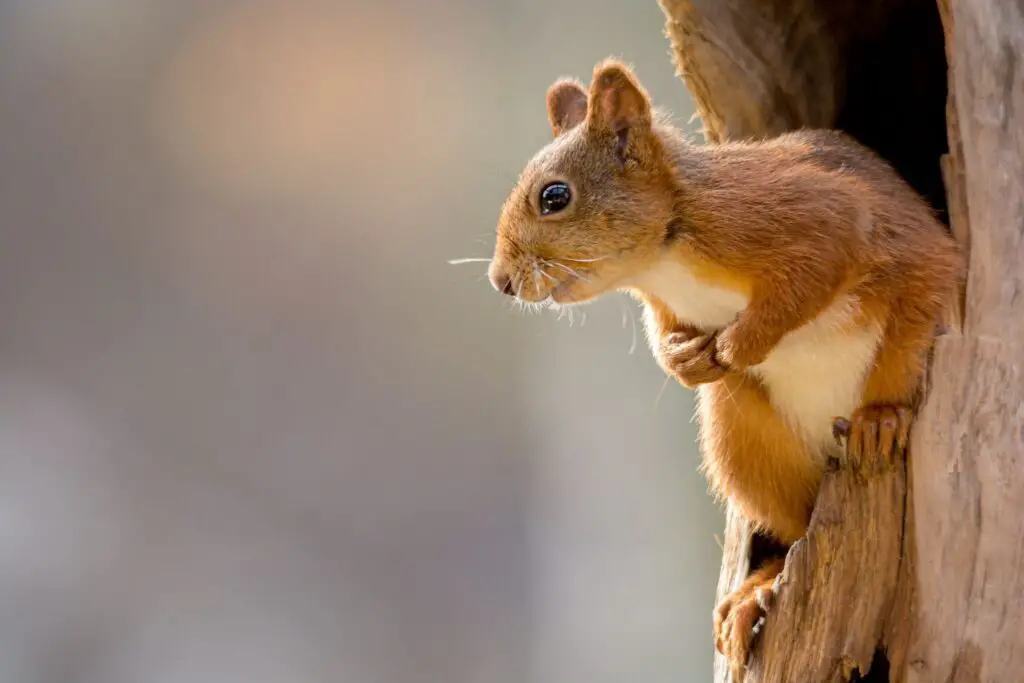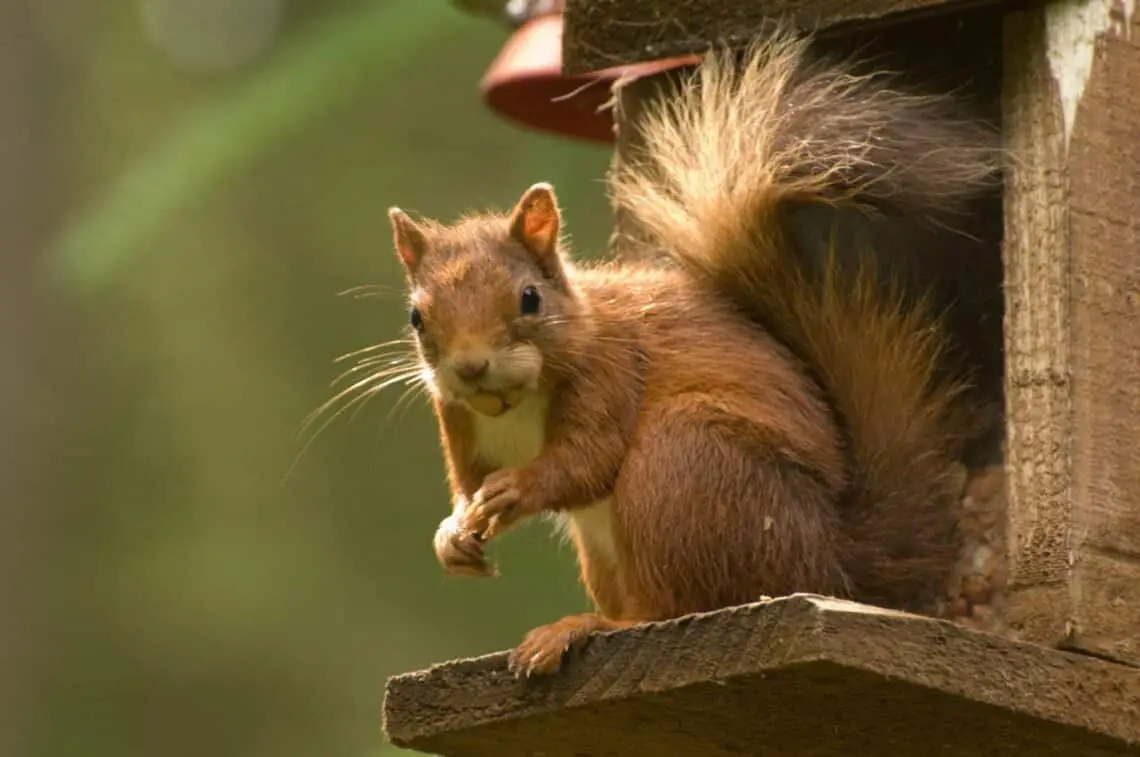Introduction
What Sound Does A Squirrel Make: The world is filled with a symphony of sounds, from the melodious chirping of birds in the morning to the rhythmic pattering of raindrops on a quiet night. Amidst this auditory tapestry, the squirrel, a ubiquitous and often whimsical creature, adds its own unique notes. While squirrels are not typically known for their vocalizations, they are far from silent inhabitants of the natural world. Squirrels belong to the family Sciuridae, which includes a wide range of species distributed across various continents, from the gray squirrels of North America to the red squirrels of Europe and Asia. These small, agile rodents are renowned for their acrobatic antics as they leap from tree to tree and scurry along branches.
One of the most recognizable sounds associated with squirrels is their chattering or chittering. This vocalization consists of rapid, high-pitched noises and is often heard when squirrels are agitated or alarmed. It serves as an alarm call, warning other squirrels in the vicinity of potential danger. So, if you’ve ever approached a squirrel too closely and heard it chattering loudly, it’s likely trying to alert its fellow squirrels to your presence. Squirrels can produce a variety of other vocalizations, including barks and screams. The bark is a sharper and more intense sound compared to chattering and is often used in territorial disputes or during aggressive encounters with other squirrels.
Squirrels may also emit a piercing scream when they are in extreme distress or facing a serious threat, such as from a predator. While vocalizations play a crucial role in squirrel communication, they are not the sole means of expression for these creatures. Squirrels baby also use body language, such as tail flicking, postural changes, and tail positions, to convey information to their peers. Understanding the combination of sounds and visual cues is essential in deciphering the complex social interactions and messages within squirrel communities. So, an auditory journey into the secret world of squirrels and discover the hidden melodies of the treetops.

Does a squirrel meow?
By observing the activity when a squirrel meows, you’ll be able to understand how squirrels keep each other safe with their threat reports. When a cat leaves the yard, a squirrel will let others know with a chirp-meow.
Squirrels are not known for producing sounds that closely resemble meowing. Instead, their vocal repertoire includes a range of distinctive noises, each serving specific purposes in their communication with other squirrels and their environment. These sounds can vary depending on the species of squirrel and the situation at hand.
One of the most common sounds attributed to squirrels is their chattering or chittering. This rapid, high-pitched noise is often heard when squirrels are alarmed, agitated, or warning others about potential threats. It’s akin to a series of quick, sharp “tsk” sounds rather than the soft, melodic meowing associated with cats. This chattering serves as an alarm call and helps alert other squirrels to potential dangers, such as approaching predators.
Squirrels may also emit a barking sound, which is distinct from meowing. The squirrel’s bark is more intense and serves as a territorial warning or a sign of aggression during disputes with other squirrels. This vocalization is often accompanied by physical displays like tail flicking and postural changes, reinforcing its message.
Why do squirrels make a quack sound?
“Whether or not they use kuks doesn’t really tell you much about what’s going on other than something is upsetting the squirrel,” says McRae. Squirrels made quaas more often in response to terrestrial threats, but sometimes used them when an aerial threat approached, as well.
Chattering: Chattering is one of the most common sounds associated with squirrels. It consists of rapid, high-pitched noises, often described as a series of quick “tsk” sounds. Squirrels use chattering as an alarm call to warn other squirrels in the vicinity of potential danger. It is often heard when they spot a predator or feel threatened.
Barking: Squirrels can emit sharp, intense barking sounds, particularly during territorial disputes or when they are engaged in aggressive encounters with other squirrels. This bark is far from the quacking sound of a duck; it is more akin to a short, sharp yelp or shout.
Screaming: When squirrels are in extreme distress or facing a severe threat, they may emit a high-pitched scream. This scream is a far cry from a duck’s quack and is characterized by its piercing, shrill nature. It serves as an urgent distress signal to other squirrels in the area.
Whistling: Some species of ground squirrels are known to produce whistling or hissing sounds when they feel threatened. These whistles are often accompanied by physical displays like tail-raising and body postures. Again, these vocalizations do not resemble a duck’s quack.
Do squirrels have a sound?
They have three acoustically distinct alarm calls: kuks, quaas, and moans,” Mr. McRae said. “The most common sound by far is the kuk, which sounds like the bark of a very, very small dog. In fact, if you take a recording of a gray squirrel kuk and drop the pitch, it sounds just like a dog barking.
Chattering and Chirping: Chattering is one of the most distinctive sounds associated with squirrels. It consists of rapid, high-pitched noises that sound like a series of quick “tsk” sounds. Squirrels use chattering to communicate alarm or agitation. When they spot a potential threat, such as a predator or an unfamiliar human, they often emit these chattering sounds to alert other squirrels in the area to the danger. It’s essentially a warning call.
Barking: Squirrels can emit sharp, intense barking sounds, especially during territorial disputes or when they are engaged in confrontations with other squirrels. This barking is typically a sign of aggression or an attempt to establish dominance in their territory. It helps prevent physical confrontations by communicating their intentions and warnings to rival squirrels.
Screaming: In moments of extreme distress or when facing a severe threat, squirrels may emit a high-pitched scream. This scream is characterized by its piercing and shrill nature and serves as an urgent distress signal to other squirrels in the vicinity. It’s a cry for help when the squirrel is in imminent danger.
Do squirrels chirp or bark?
They have a wide range of vocal features, including squeaks, barks, and grunts. Squirrels are constantly gnawing on objects, which can produce repeated scraping or rubbing sounds. When distressed, baby squirrels make high-pitched, chirping noises similar to birds.
Alarm Calls: One of the primary reasons squirrels chirp is to communicate alarm or agitation. When a squirrel spots a potential threat, such as a predator or an approaching human, it often emits these chirping sounds to alert other squirrels in the vicinity to the danger. It’s essentially a warning call that helps keep the squirrel community vigilant and safe.
Territorial Defense: Squirrels are territorial creatures, and barking is often used to establish dominance and defend their territory against rival squirrels. When a squirrel encounters another squirrel intruding on its territory, it may emit these barking sounds to communicate its presence and assert its territorial rights. This vocalization can help prevent physical confrontations by signaling intentions and warnings.
Warning and Aggression: Squirrels may also bark during aggressive encounters or confrontations with other squirrels. It’s a way to communicate aggression and establish hierarchies within the squirrel community.
Why is a squirrel chirping?
Aside from the fact that squirrels use these alarm signals to warn fellow squirrels about a predator’s presence, they also elicit an aggressive form of chirps that let predators realize that they’ve been sighted.
Warning of Danger: One of the primary reasons squirrels chirp is to communicate potential threats or dangers in their environment. When a squirrel spots a predator or perceives any form of danger, it emits chirping sounds to alert other squirrels in the vicinity. This serves as an alarm call, notifying other members of the squirrel community to be on high alert. By sharing information about the presence of a predator, squirrels collectively enhance their chances of survival.
Agitation and Anxiety: Chirping can also be a response to agitation or anxiety. Squirrels are naturally cautious animals, and they may become agitated in situations that feel unfamiliar or stressful. This can include encounters with humans, unfamiliar animals, or challenging obstacles. Chirping in these situations may serve as a way to express their emotional state or signal to others that they are in a state of unease.
Communication with Offspring: Squirrels are attentive parents, and they use chirping to communicate with their young. Mother squirrels often produce a distinct chirping sound to call their offspring or signal them to remain still and hidden when danger is nearby. Chirping in this context helps ensure the safety of their vulnerable babies.
What is a barking squirrel?
When a squirrel barks, it’s usually because they’ve spotted a potential threat, such as a predator or an intruding squirrel. The loud, harsh noise serves to alert others in the area, helping to ensure their collective safety. The intensity and frequency of the barks can clues about the perceived threat level.
Territorial Defense: Barking squirrels often use this vocalization to establish dominance and defend their territory against rival squirrels. Squirrels are territorial creatures, and disputes over territory boundaries are not uncommon. When a squirrel encounters another squirrel intruding on its territory, it may emit sharp barking sounds to communicate its presence and assert its territorial rights. This vocalization helps prevent physical confrontations by signaling intentions and warnings.
Communication of Aggression: Barking can also be a form of communication to convey aggression or assert dominance within the squirrel community. During encounters with other squirrels, especially when resources are at stake, barking may occur as a way to establish hierarchies or resolve disputes without resorting to physical combat.
Mate Attraction: In some cases, barking can be part of the courtship and mating behavior of squirrels. Male squirrels may produce unique vocalizations, including barking, as part of their efforts to attract a mate. While chirping is a more common vocalization for warning of danger, barking may also be used in situations where squirrels perceive a significant threat. This can include encounters with larger predators, such as birds of prey or snakes.
What do squirrel sounds mean?
Chirping or chattering: Squirrels may make high-pitched chirping or chattering sounds when they are excited or agitated. Barking: Squirrels may make barking sounds when they feel threatened or when they want to communicate with other squirrels.
Chirping: Chirping is one of the most recognizable squirrel sounds. It consists of rapid, high-pitched noises, often described as a series of quick “tsk” sounds. Chirping is primarily an alarm call, signaling potential threats or dangers. When a squirrel spots a predator or perceives any form of danger, it emits chirping sounds to alert other squirrels in the vicinity. This serves as a warning call that helps keep the squirrel community vigilant and safe.
Barking: Squirrels can emit sharp, intense barking sounds, especially during territorial disputes or confrontations with other squirrels. Barking serves multiple purposes, including territorial defense and communication of aggression. It helps establish dominance and resolve disputes without resorting to physical combat.
Screaming: In moments of extreme distress or when facing a severe threat, squirrels may emit a high-pitched scream. This piercing and shrill scream serves as an urgent distress signal to other squirrels in the area. It’s a cry for help when the squirrel is in imminent danger.
Are squirrels silent?
They are quite vocal creatures. In some cases, squirrels even talk to predators, warning them to stay away. Although it often sounds like squirrels are chatting away, they don’t have a language in the same way that humans do.
Chirping: Chirping is one of the most common squirrel vocalizations. It consists of rapid, high-pitched noises, often described as a series of quick “tsk” sounds. Squirrels use chirping primarily as an alarm call to warn of potential threats or dangers, such as predators.
Barking: Squirrels can emit sharp, intense barking sounds. Barking is often associated with territorial disputes, aggression, and communication within the squirrel community. It helps establish dominance and resolve conflicts.
Screaming: In moments of extreme distress or when facing severe threats, squirrels may emit high-pitched screams. These screams serve as urgent distress signals to alert other squirrels nearby.
Tail Movements: Squirrels use their tails to communicate non-verbally. Tail flicking and tail positions can convey messages about their emotional state, intentions, and social hierarchy.

Conclusion
In the world of nature’s soundscape, squirrels may not be the stars of the show, but they are undoubtedly players. Squirrels may not sing like birds, howl like wolves, or roar like lions, but their unique vocalizations and communication methods are essential for their squirrels survival and social interactions. The chattering, barking, and occasional screaming of squirrels serve as more than just a symphony of noises in the forest; they are vital signals in their complex world. Whether it’s warning of potential dangers, asserting dominance in territorial disputes, or expressing extreme distress, these sounds convey crucial information to other squirrels in their community.
The combination of vocalizations with visual cues, such as tail flicking and postural changes, creates a rich and nuanced form of communication that allows them to navigate the challenges of their environment successfully. The sounds of squirrels enriches our connection with the natural world. It invites us to pay attention to the subtle intricacies of the creatures that share our habitats, even those that may seem inconspicuous at first glance. When we listen closely to the chattering of a squirrel perched high in a tree or the bark of one defending its territory, we are granted a glimpse into their lives and the ecosystems they inhabit.
In a broader context, the sounds of squirrels also remind us of the interconnectedness of all living beings on our planet. They are a part of the intricate web of life that surrounds us, and their vocalizations are just one thread in the tapestry of biodiversity. By appreciating and studying the sounds of squirrels and other wildlife, we gain a deeper respect for the delicate balance of nature and our role in preserving it. So, the next time you find yourself in the company of these furry creatures or hear their distinctive calls echoing through the woods, take a moment to appreciate the richness of their communication and the beauty of the natural world.





No Comments